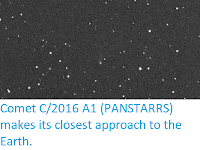Comet 74P/Smirnova-Chernykh will reach its perihelion (the closest
point
on its orbit to the Sun) on Friday 26 January 2018, when it will be
approximately 3.56 AU from the Sun (i.e. 356% of the distance between
the
Earth and the Sun, between the orbits of Mars and Jupiter),
not be particularly close to us. The comet will be in the constellation of Virgo seen
from the Earth, though it will not be naked eye visible.
Image of 74P/Smirnova-Chernykh taken from the Kyiv Comet Station in Ukraine on 29 September 2014. 480 second exposure. Comet is faint object at centre of image indicated by lines. Line crossing image is a satelite. Alexander Baransky/Fachgruppe Kometen in der VdS.
74P/Smirnova-Chernykh was discovered in March 1975 Tamara Mikhaylovna Smirnova of the Institute of Theoretical Astronomy in Leningrad in an image made in 1967 by Nikolai Stepanovich Chernykh of the Crimean Astrophysical Observatory. The designation 74/P implies that it is a Periodic Comet (comet with an orbital period of less than 200 years), and that it was the 74th such body discovered.
The orbit of 74P/Smirnova-Chernykh. In The Sky.
74P/Smirnova-Chernykh s a short period, Jupiter Family comet (a
comet with a period of less
than 20 years with an orbit angled at less than 30° to the plane of the
Solar System), with a 8.52 year orbital period and an elliptical orbit
tilted at 6.64° to the plane of the Solar System, which takes it from 3.56 AU from the Sun to 4.78 AU from the Sun (i.e. 4.78 times the average distance between the Earth and the Sun, slightly
inside the orbit of Jupiter). 74P/Smirnova-Chernykh is locked into a 3:2 orbital resonance with the planet Jupiter (i.e. completes 3 orbits for every 2 orbits completed by Jupiter), as such it is also considered to be a Quasi-Hilda Object,
See also...
Follow Sciency Thoughts on Facebook.








